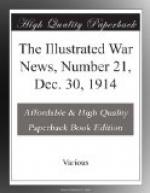Daring enough in themselves, those German visitations seemed insignificant by comparison with the raids which were being carried out almost simultaneously on the other side of the sea by our own naval airmen. For while the German aeroplanist was helping to dig a cabbage garden at Dover, one of our Squadron-Commanders—R.B. Davies, R.N.—from a Maurice-Farman biplane was much more profitably engaged in dropping a dozen bombs on a Zeppelin shed at Brussels—causing “clouds of smoke” to arise therefrom—most probably from the flames of the incendiarised air-ship.
_______________________________________________________
___________________ THE ILLUSTRATED WAR NEWS, DEC. 30, 1914—[Part 21]—5
[Illustration: THE AIR-RAID ON GERMAN WAR-SHIPS OFF CUXHAVEN: BRITISH SEA-PLANES, SISTERS TO THOSE WHICH TOOK PART IN THE BRILLIANT EXPLOIT.]
The sea-planes came into great prominence, for the first time during the war, on Christmas Day, when seven of them attacked German war-ships lying in Schillig Roads, off Cuxhaven. The attack started from a point in the vicinity of Heligoland, and the air-craft were escorted by a light-cruiser and destroyer force, together with submarines. The enemy put up a fight by means of two Zeppelins, three or four bomb-dropping sea-planes, and several submarines. Six out of the seven pilots returned safely—three were re-embarked by our ships, and three were picked up by British submarines. Flight-Commander Francis E.T. Hewlett, R.N., was reported missing. In our first photograph a sea-plane is being conveyed to her parent ship; in the second and third, sea-planes are being hoisted aboard.—[Photos. by S. and G.]




